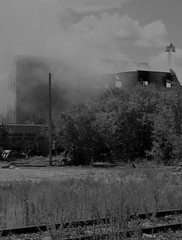Saturday, July 29, 2006
Wednesday, July 26, 2006
No surprises
Living in a central neighborhood of Winnipeg, I have no use for the evening news. (My own theory is that together, the mainstream media make up a typical suburban family: The angry grandpa (CJOB); the "well isn't that neat" grandma (CKY); the "keep my taxes low" dad (Global); the paranoid (soccer) mom (Free Press); the annoying, overidealistic daughter (CBC); and, finally, the bratty son (Sun) obsessed with boobies and things that go vroom-vroom.) And so it isn't too often that I find myself tuning in at six o' clock. But tonight I did, to Global news, and in two back-to-back segments, Gord LeClerc told me a couple of things already known to anyone who has payed attention:
1) The Province and the City can't afford to build two interchanges where the extended Kenaston will meet Bison Drive. Instead, traffic lights will control an at-grade intersection. But even with this, the cost of the Kenaston project will be $38M; of which the City will pay $17M. A dozen or so rich developers are thrilled.
pay $17M. A dozen or so rich developers are thrilled.
2) The planned Federal and Provincial contribution to Glen Murray's planned transit improvements (aka: BRT) on the University route did infact vanish, and will not be redirected to community centres, as Katz said they would in Autumn 2004. Turns out, the City only has an extra $10M (not the tri-level $43M) to spend on community centres. Of course, this only goes so far in an ever-thinning city, and (so far) four community centres are being closed, and two will amalgamate with others "nearby".
$17M (ironically what the City's contribution to phase one of the BRT plan would have been) for extending Kenaston into the south-western corner of the city. $10M for giving kids--who may not have the luxury of cottages and maternal chauffers--something to do besides stealing cars and use drugs. Like the smell of an overflowing dumpster on a hot summer's day, the old lies of a few greedy men are becoming more and more obvious and sinister.
1) The Province and the City can't afford to build two interchanges where the extended Kenaston will meet Bison Drive. Instead, traffic lights will control an at-grade intersection. But even with this, the cost of the Kenaston project will be $38M; of which the City will
 pay $17M. A dozen or so rich developers are thrilled.
pay $17M. A dozen or so rich developers are thrilled. 2) The planned Federal and Provincial contribution to Glen Murray's planned transit improvements (aka: BRT) on the University route did infact vanish, and will not be redirected to community centres, as Katz said they would in Autumn 2004. Turns out, the City only has an extra $10M (not the tri-level $43M) to spend on community centres. Of course, this only goes so far in an ever-thinning city, and (so far) four community centres are being closed, and two will amalgamate with others "nearby".
$17M (ironically what the City's contribution to phase one of the BRT plan would have been) for extending Kenaston into the south-western corner of the city. $10M for giving kids--who may not have the luxury of cottages and maternal chauffers--something to do besides stealing cars and use drugs. Like the smell of an overflowing dumpster on a hot summer's day, the old lies of a few greedy men are becoming more and more obvious and sinister.
Wednesday, July 19, 2006
Hell's Hundred Acres
 There once was a neighborhood that was, for a brief period of time, its city's most desirable place to live. This changed by the end of the 19th century, as the refined residents began to move out, and industries--with their poor workforce in tow--moved in. Into the 20th century, the area was considered an "industrial slum", and like the wealthy residents of an earlier time, the industries that with the ability to, moved out to more spacious quarters. The poor residents left, too, and the area faced massive depopulation and economic stagnation. Fires in the old warehouses occured so frequently that the area came to be known as "Hell's Hundred Acres". The old buildings were considered eyesores, and the traffic engineers began to circle around, hoping the area would be cleared for expressways.
There once was a neighborhood that was, for a brief period of time, its city's most desirable place to live. This changed by the end of the 19th century, as the refined residents began to move out, and industries--with their poor workforce in tow--moved in. Into the 20th century, the area was considered an "industrial slum", and like the wealthy residents of an earlier time, the industries that with the ability to, moved out to more spacious quarters. The poor residents left, too, and the area faced massive depopulation and economic stagnation. Fires in the old warehouses occured so frequently that the area came to be known as "Hell's Hundred Acres". The old buildings were considered eyesores, and the traffic engineers began to circle around, hoping the area would be cleared for expressways.In the background, things started to change, slowly and quietly. Artists--almost always the poor ones at the margins of their disciplines--begin to move into the old buildings in Hell's Hundred Acres, and use them to live and work. Often, doing so was against zoning regulations, and meant going without hot water or electricity. But the artists loved the buildings, and the beat character of the neighborhood anyway. In a neighborhood so forgotten and despised, they could be pioneers both in art and urban life. For years, no one noticed them and what they were doing.
Eventually, of course, they did, and today, Hell's Hundred Acres is known as SoHo, one of New York City's most famous, trendy and upscale of neighborhoods.
 The Winnipeg commuters who stare down from the Disraeli Freeway at another burned out warehouse today, may not notice the good things happening in Point Douglas, either. Nor would City Hall, or the whole Take Spirited Pride BIZ machine. They are probably not aware that two of Winnipeg's most well-known current artists live in South Point Douglas, among many others. They are probably not aware that scores of trust-funded artschool kids pour into the neighborhood for late-night parties. They are probably not aware that the best art shows are in Point Douglas' back lanes and loading docks. Even if they were, some would likely despise all this, given the hostile philistinian attitude the permeates the city. But whether they notice and appreciate it or not, more and more (young) people are noticing, and things are quietly improving, even while Higgins and Annabella looks like TV footage from Beiruit.
The Winnipeg commuters who stare down from the Disraeli Freeway at another burned out warehouse today, may not notice the good things happening in Point Douglas, either. Nor would City Hall, or the whole Take Spirited Pride BIZ machine. They are probably not aware that two of Winnipeg's most well-known current artists live in South Point Douglas, among many others. They are probably not aware that scores of trust-funded artschool kids pour into the neighborhood for late-night parties. They are probably not aware that the best art shows are in Point Douglas' back lanes and loading docks. Even if they were, some would likely despise all this, given the hostile philistinian attitude the permeates the city. But whether they notice and appreciate it or not, more and more (young) people are noticing, and things are quietly improving, even while Higgins and Annabella looks like TV footage from Beiruit. In hindsight, I believe that in 2006, creative graffiti artists will have done more to improve this city than politicians and booster groups did. For now, they carry on in the background, as almost all good things in Winnipeg do.
Monday, July 17, 2006
This sign was spotted this afternoon when I was crossing into St. Boniface; it just blew my mind:

What this says (in both official languages):
1) "We don't like enterprising people who attempt to create micro-economies on our streets... let them works in pig processing plants."
2) "We want to keep the city's big destinations boring, for tourists and locals alike."
3) "Our mayor is only business-friendly to his friends... and don't think of giving them any competition."
4) "Want to buy a cold bottle of water, cheap sunglasses, a smokie, hand-made jewelery, a painting, falafel, ice cream, etc? Go to the mall."
5) "Spirited energy? Not in our public places."

What this says (in both official languages):
1) "We don't like enterprising people who attempt to create micro-economies on our streets... let them works in pig processing plants."
2) "We want to keep the city's big destinations boring, for tourists and locals alike."
3) "Our mayor is only business-friendly to his friends... and don't think of giving them any competition."
4) "Want to buy a cold bottle of water, cheap sunglasses, a smokie, hand-made jewelery, a painting, falafel, ice cream, etc? Go to the mall."
5) "Spirited energy? Not in our public places."

